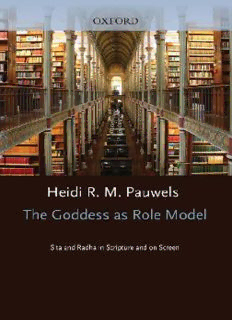
The Goddess as Role Model: Sita and Radha in Scripture and on Screen PDF
Preview The Goddess as Role Model: Sita and Radha in Scripture and on Screen
The Goddess as Role Model This page intentionally left blank The Goddess as Role Model S¯ıta and Radha in Scripture and on Screen heidi r.m. pauwels 1 2008 1 OxfordUniversityPress,Inc.,publishesworksthatfurther OxfordUniversity’sobjectiveofexcellence inresearch,scholarship,andeducation. Oxford NewYork Auckland CapeTown DaresSalaam HongKong Karachi KualaLumpur Madrid Melbourne MexicoCity Nairobi NewDelhi Shanghai Taipei Toronto Withofficesin Argentina Austria Brazil Chile CzechRepublic France Greece Guatemala Hungary Italy Japan Poland Portugal Singapore SouthKorea Switzerland Thailand Turkey Ukraine Vietnam Copyright#2008byOxfordUniversityPress,Inc. PublishedbyOxfordUniversityPress,Inc. 198MadisonAvenue,NewYork,NewYork10016 www.oup.com OxfordisaregisteredtrademarkofOxfordUniversityPress Allrightsreserved.Nopartofthispublicationmaybereproduced, storedinaretrievalsystem,ortransmitted,inanyformorbyanymeans, electronic,mechanical,photocopying,recording,orotherwise, withoutthepriorpermissionofOxfordUniversityPress. LibraryofCongressCataloging-in-PublicationData Pauwels,HeidiRikaMaria. Thegoddessasrolemodel:SitaandRadhainscriptureandonthescreen/HeidiR.M.Pauwels. p.cm. Includesbibliographicalreferencesandindex. ISBN978-0-19-536990-8 1. Sita(Hindudeity) 2. Radha(Hindudeity) 3. WomeninHinduism. 4. Love—Religious aspects—Hinduism. 5. Hinduism—Socialaspects. I. Title. BL1225.S57P382008 294.5'2114—dc22 2008009797 9 8 7 6 5 4 3 2 1 PrintedintheUnitedStatesofAmerica onacid-freepaper Dedicated to my husband jinha kem rah¯ı bhavana jais¯ı prabhu murati tinha dekh¯ı tais¯ı Everyone perceives the Lord according to his own predisposition. —Ram Carit Manas This page intentionally left blank Preface: An Auspicious Confluence This book has been in the makingfor overa decade. It isa saxgam, an auspicious confluence,in more than one sense. First, it brings togethertwo prominent Hindu goddesses, S¯ıtaand Radha. Second, it is a confluence of myth and real life, as it is looking at how myth ‘‘matters’’ in presentingrole models forwomen. Third, itlooks at the goddesses as portrayed in three different types of texts, Sanskrit, medieval Hindi, and modern film andtelevision series. Thus it brings together‘‘texts’’ of differentprovenance. It was, appropriately, a confluenceof circumstances that led to my being in India when themythological serieswere first aired on television. This gave me the opportunity to watch them as they un- folded, an opportunity I might have missed had itnot been formy Vrindaban guru, the late Shri Baldev Lal Goswami (Chote Sarkar), who insisted I spend some Sundaymornings in 1987 watching episodesof thetelevised versions of theepics with his family athis house. Iconfess that at thetime I did so reluctantly, uneasy about spending myprecious time in India watching television—of poor transmission quality to boot. I would have rather read with him the medievalKrishnapoetryIhadsetouttotranslateandinterpret.Now, Iamgratefultohimfor‘‘sowingtheseed’’(b¯ıja)offutureworks,as goodgurusdo.Hegavemetheinvaluableopportunitytotastefirsthand theinfluenceoftheseseries,andtolearnthevaluablelessonthat, while in India, be focused, but do not close yourself off from the wondrousl¯ılasunfoldingbeforeyoureyes,betheyreallifeorreellife. viii preface The seed came to fruition through another lucky confluence between teaching and research. My first research focused on the goddess Radha, and whenIgotmyfirstteachingjobattheSchoolofOrientalandAfricanStudies (SOAS), London, I was finalizing translations for my first book on a Braj reworkingofKrishna’sdancewiththeRadhaandtheGop¯ısinthewoods,the Ras-pan˜cadhyay¯ı.AsIwasteachingAvadh¯ıatSOAS,Iwasreadingatthesame timewithmystudentsfromTuls¯ıdas’sRamcaritmanas—thepassagesofS¯ıta’s resolve to join Rama in exile in the woods. While preparing wordlists for the class,IwasstruckbythesimilaritiesinwordingandsentimentofS¯ıta’sresolve withthatoftheGop¯ıstojoinKrishnaintheforest.Theinterestinthetelevised versions came in that same Avadh¯ı class. The students had been voicing a common sentiment of doubt about the usefulness of reading medieval texts for understanding contemporary India, so I showed episodes from Sagar’s Ramayantoillustratethecontemporaryrelevanceofthetext.Whendoingso, I was struck by thedifferences withthe texts we had read. ThelinkwithpopularHindimoviescamein1995,whenIhadachanceto view in a crowded London theatre the full version of the hit movie Hum aap ke hain koun...! and heard recited the Manas passages we had just read in class! I was delighted to have more evidence to tell my film-loving students howtheywouldbenefitsoobviouslyfromtheirhardworkinthemedievaltext class. I am grateful to Munni Kabir for inspiring me with her love for Hindi moviesandhermessagetotakethemseriously,andinparticulartopayclose attention to thesong-and-dance sequences. Thus, at the origin of this book is a desire to show the relevance of the medievaltextsIlovetostudentsofmodernIndia.Ifeelthatmycontributionto make is to share my love of these influential classical texts with a wider au- dience. I hope that I will not be misunderstood as intending to reduce the Hindi film to a mythological Ur-story but that I will instead alert viewers of Hindifilmstoawealthofnuancesandvariantsthatmightotherwiseremain unmined.Ithinkhisbookabundantlyillustrateshowstudyofmythologycan help to understand contemporary film. TheS¯ıtapartsofthreechaptersinthisbook(1–3)aredrasticallyrewritten versionsofpaperspresentedatandfirstwrittenupforRamayapaconferences organized by Mandakranta Bose of the University of British Columbia, Van- couver, in 1999 and 2000. I am very grateful for her and Vidyut Aklujkar’s encouragement and for the opportunity to sound out my ideas among spe- cialists at an early stage in the development of the book. (These essays are published as Pauwels 2000 and 2004a.) The section on S¯ıta in chapter 4 in thisbookwasfirstpresentedataSouthAsiaConferenceofthePacificNorth- West in 1996, and subsequently at a conference in Cambridge, UK, in preface ix 1997.(AshortarticleonthetopicwasPauwels2004b.)IamgratefultoLynn ThomasandJacquelineHirstfortheircomments.Asummaryofchapter1was also presented in Paris, when I was visiting at the E´cole Pratique des Hautes E´tudesin2005.IamgratefulforthekindhospitalityofFranc¸oiseMallisonand NaliniDelvoyeandfortheirsuggestionsandthoseoftheaudience.Finally,the section on Rukmip¯ı in chapter 2 is a variant of a paper first presented at the annualmeetingoftheAmericanOrientalSocietyinSeattlein2005andpub- lishedintheJournaloftheRoyalAsiaticSocietyin2007.However,inthepub- lished article I do not touch upon the televised version, and instead compare theBraj versionwith aMarwari retelling of thestory. IammostgratefultoCynthiaReadofOxfordUniversityPressforseeing the book through to publication and for soliciting two superb anonymous readers’ reviews, which were both supportive and tactfully critical with ex- cellentsuggestions.Thereviewershelpedmefocusmyargumentandprovided evensome elegantturnsofphrase thatIhaveincorporatedinthebook.Iam very grateful for their comments. ItisapleasuretoacknowledgeCarolynBrownHeinz,forherenthusiastic permission to use the photo on the cover, as well as for sharing with me her vastanthropological expertiseon theregion ofS¯ıta’sbirth, Mithila. IwanttothankespeciallymygoodfriendandrespectedcolleagueSwapna SharmaofVrindabanforhelpingmewiththetranslationsfromtheBrajtexts. Sheclarifiedmanyobscurepassagesandsavedmefromseveralembarrassing mistakes. More important, in her own devotion to Radha, she provided me with an inspiring role model herself. There is no better way to come to understand and love a culture one has not grown up in than through a true friend. I wish to thank wholeheartedly my colleagues at the University of Wa- shington, especially Michael Shapiro, for taking the time to look through an earlydraftofthisbookandofferingadvice,andalsoVirginiaVanDykeforgreat discussions on politics and a reading of some politically relevant portions in thiswork. And many thanks to the students at the University of Washington who took my classes on medieval Hindi, Indian literature in translation, Indian goddesses,andRamayapaincomparativeperspective;Iamespeciallygrateful to Valerie Ritter (now at the University of Chicago) for many fascinating dis- cussions about Radha and Krishna’s accosting the Gop¯ıs. Thanks to Prem Pahlajraiforhisinsightfulcommentsonanearlyversionoftheintroductionand chapter 6. I thank my students for their enthusiasm, keen interest, and good discussions. This book was largely written during my sabbatical in 2004–5; IamgratefultotheUniversityofWashingtonforteachingrelief.
Description: